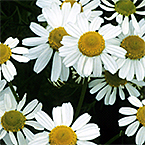Chamomile

On this page:
Introduction
This fact sheet provides basic information about chamomile—common names, what the science says, potential side effects and cautions, and resources for more information.
Two types of chamomile have been used for health conditions: German chamomile and Roman chamomile. While the two kinds are thought to have similar effects on the body, the German variety is more commonly used in the United States and is the focus of this fact sheet.
Chamomile has been widely used in children and adults for thousands of years for a variety of health conditions. Today, chamomile is used as a folk or traditional remedy for sleeplessness, anxiety, and gastrointestinal conditions such as upset stomach, gas, and diarrhea. It is also used topically for skin conditions and for mouth ulcers resulting from cancer treatment.
The flowering tops of the chamomile plant are used to make teas, liquid extracts, capsules, or tablets. The herb can also be applied to the skin as a cream or an ointment, or used as a mouth rinse.
What the Science Says
- Chamomile has not been well studied in people so there is little evidence to support its use for any condition.
- Some early studies point to chamomile’s possible benefits for certain skin conditions and for mouth ulcers caused by chemotherapy or radiation.
- In combination with other herbs, chamomile may be of some benefit for upset stomach, for diarrhea in children, and for infants with colic.
- NCCAM-funded research includes studies of chamomile for generalized anxiety disorder and abdominal pain caused by children’s bowel disorders.
Side Effects and Cautions
- There are reports of allergic reactions in people who have eaten or come into contact with chamomile products. Reactions can include skin rashes, throat swelling, shortness of breath, and anaphylaxis (a life-threatening allergic reaction).
- People are more likely to experience allergic reactions to chamomile if they are allergic to related plants in the daisy family, which includes ragweed, chrysanthemums, marigolds, and daisies.
- Tell all your health care providers about any complementary health practices you use. Give them a full picture of what you do to manage your health. This will help to ensure coordinated and safe care. For tips about talking with your health care providers about complementary and alternative medicine, see NCCAM's Time To Talk campaign.
Search the scientific literature for potential herb-drug interactions
Sources
- Chamomile (Matricaria recutita, Chamaemelum nobile). Natural Standard Database Web site. Accessed at www.naturalstandard.com on May 8, 2009.
- Chamomile flower, German. In: Blumenthal M, Goldberg A, Brinckman J, eds. Herbal Medicine: Expanded Commission E Monographs. Newton, MA: Lippincott Williams & Wilkins; 2000:57–61.
- German chamomile. Natural Medicines Comprehensive Database Web site. Accessed at www.naturaldatabase.com on May 8, 2009.
For More Information
NCCAM Clearinghouse
The NCCAM Clearinghouse provides information on NCCAM and complementary health approaches, including publications and searches of Federal databases of scientific and medical literature. The Clearinghouse does not provide medical advice, treatment recommendations, or referrals to practitioners.
PubMed®
A service of the National Library of Medicine (NLM), PubMed® contains publication information and (in most cases) brief summaries of articles from scientific and medical journals.
Office of Dietary Supplements (ODS), National Institutes of Health (NIH)
ODS seeks to strengthen knowledge and understanding of dietary supplements by evaluating scientific information, supporting research, sharing research results, and educating the public. Its resources include publications (such as Dietary Supplements: What You Need to Know), fact sheets on a variety of specific supplement ingredients and products (such as vitamin D and multivitamin/mineral supplements), and the PubMed® Dietary Supplement Subset.
NIH National Library of Medicine's MedlinePlus
This publication is not copyrighted and is in the public domain. Duplication is encouraged.
* Note: PDF files require a viewer such as the free Adobe Reader.
